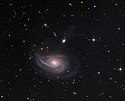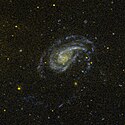NGC 772
| Galaxie NGC 772 | |
|---|---|
 | |
| NGC 772, aufgenommen mithilfe des nördlichen Gemini-Teleskops. | |
| AladinLite | |
| Sternbild | Widder |
| Position Äquinoktium: J2000.0, Epoche: J2000.0 | |
| Rektaszension | 01h 59m 19,6s[1] |
| Deklination | +19° 00′ 27″[1] |
| Erscheinungsbild | |
| Morphologischer Typ | SA(s)b HII[1] |
| Helligkeit (visuell) | 10,3 mag[2] |
| Helligkeit (B-Band) | 11,1 mag[2] |
| Winkelausdehnung | 7,2′ × 4,3′[2] |
| Positionswinkel | 130°[2] |
| Flächenhelligkeit | 13,9 mag/arcmin²[2] |
| Physikalische Daten | |
| Zugehörigkeit | LGG 40[1] |
| Rotverschiebung | 0,008246 ± 0,000010[1] |
| Radialgeschwindigkeit | (2472 ± 3) km/s[1] |
| Hubbledistanz vrad / H0 | (114 ± 8) · 106 Lj (35,1 ± 2,5) Mpc [1] |
| Durchmesser | ca. 220000 Lj |
| Geschichte | |
| Entdeckung | Wilhelm Herschel |
| Entdeckungsdatum | 29. November 1785 |
| Katalogbezeichnungen | |
| NGC 772 • UGC 1466 • PGC 7525 • CGCG 461-018 • MCG +03-06-011 • IRAS 01565+1845 • Arp 78 • GC 463 • H I 112 • h 181 • HIPASS J0159+18 • Kara 80 | |
NGC 772 ist die Bezeichnung einer Spiralgalaxie vom Typ Sb im Sternbild Widder auf der Ekliptik. Sie ist rund 114 Millionen Lichtjahre von der Milchstraße entfernt und hat einen Durchmesser von etwa 240.000 Lichtjahren.
Die elliptische Galaxie NGC 770 ist eine Satellitengalaxie von NGC 772; sie interagiert mit letzterer und ist für die Verformung eines ihrer Spiralarme und den darin stattfindenden "starburst" verantwortlich. Diese Zwerggalaxie hat inzwischen einen projizierten Abstand von knapp 100.000 Lichtjahren zu ihrem Begleiter erreicht[3]. Die beiden Galaxien sind zusammen als Arp 78 im Arp-Katalog verzeichnet. Halton Arp gliederte seinen Katalog ungewöhnlicher Galaxien nach rein morphologischen Kriterien in Gruppen. Diese Galaxie gehört zu der Klasse Spiralgalaxien mit einem kleinen Begleiter hoher Flächenhelligkeit auf einem Arm (Arp-Katalog).
NGC 772 wurde am 29. November 1785 vom deutsch-britischen Astronomen Friedrich Wilhelm Herschel entdeckt.[4]
Abbildungen
- (c) ESA/Hubble, CC BY 4.0
Hochaufgelöste Abbildung des Zentrums, erstellt mithilfe des Hubble-Weltraumteleskops
Aufnahme des Ultraviolettspektrums mithilfe von GALEX
NGC 772-Gruppe (LGG 40)
| Galaxie | Alternativname | Entfernung/Mio. Lj |
|---|---|---|
| NGC 772 | PGC 7525 | 114 |
| NGC 770 | PGC 7517 | 118 |
| PGC 7826 | UGC 1546 | 110 |
| PGC 7750 | UGC 1519 | 109 |
Weblinks
- Spektrum.de: Amateuraufnahmen [1]
- ARP ATLAS OF PECULIAR GALAXIES
- Arp 78 im APOD vom 7. Juli 2011
- A Rival to the Milky Way
- Seligman Arp
Literatur
- Jeff Kanipe und Dennis Webb: The Arp Atlas of Peculiar Galaxies – A Chronicle and Observer´s Guide, Richmond 2006, ISBN 978-0-943396-76-7
Einzelnachweise
Auf dieser Seite verwendete Medien
Autor/Urheber:
Credit:
International Gemini Observatory/NOIRLab/NSF/AURA
Image processing: T.A. Rector (University of Alaska Anchorage), J. Miller (Gemini Observatory/NSF's NOIRLab), M. Zamani & D. de Martin, Lizenz: CC BY 4.0Galaxy NGC 772
The overdeveloped spiral arm of the galaxy NGC 772, which was created by tidal interactions with an unruly neighbor, dominates this observation made by astronomers using the Gemini North telescope located near the summit of Maunakea in Hawai‘i.
Credit:
International Gemini Observatory/NOIRLab/NSF/AURA Image processing: T.A. Rector (University of Alaska Anchorage), J. Miller (Gemini Observatory/NSF's NOIRLab), M. Zamani & D. de Martin
Coordinates Position (RA): 1 59 17.66 Position (Dec): 19° 1' 19.76" Field of view: 4.14 x 4.49 arcminutes Orientation: North is 180.0° left of vertical
Colors & filters Band Wavelength Telescope Optical g 475 nm Gemini North GMOS-N Optical r 630 nm Gemini North GMOS-N Optical i 780 nm Gemini North GMOS-N.
Autor/Urheber: Ole Nielsen, Lizenz: CC BY-SA 2.5
Two supernova (SN 2003hl & SN 2003iq) in NGC 772 galaxy and minor planet 6223 Dahl
Autor/Urheber: Credit Line and Copyright Adam Block/Mount Lemmon SkyCenter/University of Arizona, Lizenz: CC BY-SA 3.0 us
NGC 772
Picture Details:
Optics 24-inch RC Optical Systems Telescope Camera SBIG STL11000 CCD Camera Filters Custom Scientific Dates November 21st 2009 Location Mount Lemmon SkyCenter Exposure LRGB: 195:70:70:70 Acquisition ACP Observatory Control Software (DC-3 Dreams),TheSky (Software Bisque), Maxim DL/CCD (Cyanogen) Processing CCDStack (CCDWare), Mira (MiraMetrics), Photoshop CS3 (Adobe)Credit Line and Copyright Sid Leach/Adam Block/Mount Lemmon SkyCenter/University of Arizona
(c) ESA/Hubble, CC BY 4.0
The Universe is simply so vast that it can be difficult to maintain a sense of scale. Many galaxies we see through telescopes such as the NASA/ESA Hubble Space Telescope, the source of this beautiful Picture of the Week, look relatively similar: spiralling arms, a glowing centre, and a mixture of bright specks of star formation and dark ripples of cosmic dust weaving throughout.
This galaxy, a spiral galaxy named NGC 772, is no exception. It actually has much in common with our home galaxy, the Milky Way. Each boasts a few satellite galaxies, small galaxies that closely orbit and are gravitationally bound to their parent galaxies. One of NGC 772’s spiral arms has been distorted and disrupted by one of these satellites (NGC 770 — not visible in the image here), leaving it elongated and asymmetrical.
However, the two are also different in a few key ways. For one, NGC 772 is both a peculiar and an unbarred spiral galaxy; respectively, this means that it is somewhat odd in size, shape, or composition, and that it lacks a central feature known as a bar, which we see in many galaxies throughout the cosmos — including the Milky Way. These bars are built of gas and stars, and are thought to funnel and transport material through the galactic core, possibly fueling and igniting various processes such as star formation.NGC 772 by GALEX








